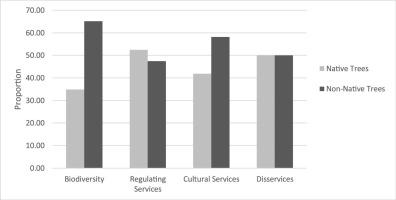当前位置:
X-MOL 学术
›
Urban Forestry Urban Green.
›
论文详情
Our official English website, www.x-mol.net, welcomes your
feedback! (Note: you will need to create a separate account there.)
Quantifying the contributions of native and non-native trees to a city’s biodiversity and ecosystem services
Urban Forestry & Urban Greening ( IF 6.0 ) Pub Date : 2020-12-01 , DOI: 10.1016/j.ufug.2020.126861 Martin A. Schlaepfer , Benjamin P. Guinaudeau , Pascal Martin , Nicolas Wyler
Urban Forestry & Urban Greening ( IF 6.0 ) Pub Date : 2020-12-01 , DOI: 10.1016/j.ufug.2020.126861 Martin A. Schlaepfer , Benjamin P. Guinaudeau , Pascal Martin , Nicolas Wyler

|
Abstract Urban trees are appreciated for their intrinsic value and their contributions to human well-being. Here, we analysed a database of 115’686 non-forest trees (1’025 species) to quantify the present contributions of native and non-native trees to biodiversity (taxonomic richness) in the metropolitan area of Geneva, Switzerland. Non-native trees made up 90% of species and 40% of individuals. A subset of these individuals with more detailed phenotypic information (N = 50’718 trees; 527 species) was used to quantify five regulating ecosystem services (micro-particle capture, carbon sequestration, water interception, microclimatic cooling, and support for pollinators), three cultural ecosystem services (natural heritage, recreational, and aesthetic value) and two disservices (allergies and biological invasiveness). Non-native and native trees generated roughly identical regulating services, on a per-tree basis, as these are linked primarily to tree morphology rather than to tree-origin. Non-native trees generated cultural ecosystem services that were greater than native trees, on a per-tree basis, with the exception of the notion of “natural heritage”. For example, 79% (163/207) of trees independently identified as “remarkable” by the canton of Geneva were non-native. Our results illustrate that non-native trees represent a significant source of biodiversity and ecosystem services both in absolute terms and on a per-tree basis. Given the empirical importance of non-native trees in many cities, and the likelihood that their importance will increase with future climate change, we suggest that non-native trees be considered in conservation assessments and strategic planning both for intrinsic reasons and for their contributions to human well-being.
中文翻译:

量化本地和非本地树木对城市生物多样性和生态系统服务的贡献
摘要 城市树木因其内在价值和对人类福祉的贡献而受到赞赏。在这里,我们分析了一个包含 115,686 棵非森林树木(1,025 种)的数据库,以量化瑞士日内瓦大都市区本地和非本地树木对生物多样性(分类丰富度)的当前贡献。非本地树木占物种的 90% 和个体的 40%。这些具有更详细表型信息的个体子集(N = 50,718 棵树;527 种)被用于量化五种调节性生态系统服务(微粒捕获、碳封存、截水、微气候冷却和对传粉者的支持),三种文化生态系统服务(自然遗产、娱乐和审美价值)和两种损害(过敏和生物入侵)。非本地和本地树木在每棵树的基础上产生大致相同的调节服务,因为这些主要与树木形态而不是树木起源有关。除了“自然遗产”的概念外,非本土树木产生的文化生态系统服务比每棵树都多于本土树木。例如,被日内瓦州独立认定为“卓越”的树木中有 79% (163/207) 是非本土的。我们的结果表明,非本地树木在绝对值和每棵树的基础上都是生物多样性和生态系统服务的重要来源。鉴于非本地树木在许多城市的经验重要性,以及它们的重要性随着未来气候变化而增加的可能性,
更新日期:2020-12-01
中文翻译:

量化本地和非本地树木对城市生物多样性和生态系统服务的贡献
摘要 城市树木因其内在价值和对人类福祉的贡献而受到赞赏。在这里,我们分析了一个包含 115,686 棵非森林树木(1,025 种)的数据库,以量化瑞士日内瓦大都市区本地和非本地树木对生物多样性(分类丰富度)的当前贡献。非本地树木占物种的 90% 和个体的 40%。这些具有更详细表型信息的个体子集(N = 50,718 棵树;527 种)被用于量化五种调节性生态系统服务(微粒捕获、碳封存、截水、微气候冷却和对传粉者的支持),三种文化生态系统服务(自然遗产、娱乐和审美价值)和两种损害(过敏和生物入侵)。非本地和本地树木在每棵树的基础上产生大致相同的调节服务,因为这些主要与树木形态而不是树木起源有关。除了“自然遗产”的概念外,非本土树木产生的文化生态系统服务比每棵树都多于本土树木。例如,被日内瓦州独立认定为“卓越”的树木中有 79% (163/207) 是非本土的。我们的结果表明,非本地树木在绝对值和每棵树的基础上都是生物多样性和生态系统服务的重要来源。鉴于非本地树木在许多城市的经验重要性,以及它们的重要性随着未来气候变化而增加的可能性,











































 京公网安备 11010802027423号
京公网安备 11010802027423号